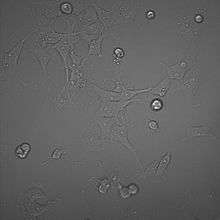COS cells

COS are fibroblast-like cell lines derived from monkey kidney tissue. COS cells are obtained by immortalizing CV-1 cells[1] with a version of the SV40 virus that can produce large T antigen but has a defect in genomic replication.[2] The CV-1 cell line in turn was derived from the kidney of the African green monkey.
The acronym "COS" is derived from the cells being CV-1 (simian) in Origin, and carrying the SV40 genetic material.[2] Two forms of COS cell lines commonly used are COS-1 and COS-7.
Applications
The COS cell lines are often used by biologists when studying the monkey virus SV40. Cells from these lines are also often transfected to produce recombinant proteins for molecular biology, biochemistry, and cell biology experiments.
When an expression construct with an SV40 promoter is introduced into COS cells, the vector can be replicated substantially by the large T antigen.
References
| Wikimedia Commons has media related to COS cells. |
- ↑ Jensen FC, Girardi AJ, Gilden RV, Koprowski H (July 1964). "Infection of human and simian tissue cultures with rous sarcoma virus". Proc. Natl. Acad. Sci. U.S.A. 52: 53–9. doi:10.1073/pnas.52.1.53. PMC 300571
 . PMID 14192657.
. PMID 14192657. - 1 2 Gluzman Y (January 1981). "SV40-transformed simian cells support the replication of early SV40 mutants". Cell. 23 (1): 175–82. doi:10.1016/0092-8674(81)90282-8. PMID 6260373.